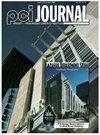Investigation of repair techniques for deteriorated end regions of prestressed concrete bridge girders
IF 0.9
4区 工程技术
Q4 CONSTRUCTION & BUILDING TECHNOLOGY
引用次数: 0
Abstract
Deterioration of the end regions of prestressed concrete bridge girders is commonly observed in the field when girders are exposed to chloride-laden water that has leaked through failed expansion joints. Because the deterioration is often localized to the end regions of the girders, reliable repair techniques can provide a means to extend girder service life, avoiding the need for immediate superstructure replacement. To evaluate different repair methods and identify key design considerations for end region repair, shear tests to failure were conducted on prestressed concrete girders extracted from a decommissioned superstructure. Three repair systems were evaluated: an externally bonded fiber-reinforced-polymer (FRP) system, a near-surface-mounted FRP system, and a concrete end block. Only the externally bonded FRP system successfully restored both the strength and initial stiffness of the girder. Although the other two methods were not successful, the tests on the repaired girders highlight important factors that must be considered when designing repairs or conducting further research. The tests also demonstrate that end region deterioration can cause significant (> 40%) reductions in strength, underscoring the importance of addressing such deterioration observed in the field.预应力混凝土桥梁端部劣化修复技术研究
预应力混凝土桥梁梁端部的劣化是现场普遍观察到的,当梁暴露于通过失效伸缩缝泄漏的含氯水时。由于退化通常局限于梁的末端区域,可靠的修复技术可以提供延长梁使用寿命的手段,避免立即更换上部结构。为了评估不同的修复方法并确定端区修复的关键设计考虑因素,对从退役上层建筑中提取的预应力混凝土梁进行了破坏剪切试验。评估了三种修复系统:外部粘合纤维增强聚合物(FRP)系统,近表面安装FRP系统和混凝土端块。只有外部粘结FRP系统成功地恢复了梁的强度和初始刚度。虽然其他两种方法都不成功,但对修复梁的试验突出了在设计修复或进行进一步研究时必须考虑的重要因素。测试还表明,端区劣化会导致强度显著降低(约40%),强调了解决现场观察到的劣化问题的重要性。
本文章由计算机程序翻译,如有差异,请以英文原文为准。
求助全文
约1分钟内获得全文
求助全文

 求助内容:
求助内容: 应助结果提醒方式:
应助结果提醒方式:


